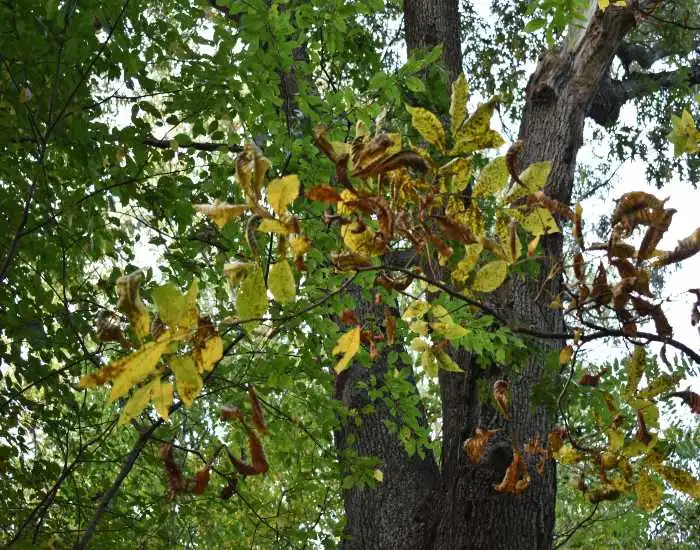Top Tree and Shrub Diseases in New York
Healthy trees and shrubs are the foundation of any landscape, providing shade, beauty, and wildlife habitat. But, like all living things, trees and shrubs can suffer from diseases that weaken or kill them. Learn about the most common tree and shrub diseases, how to identify them, and prevention and treatment tips to keep your trees and shrubs healthy for years to come.
Causes and Classifications of Tree and Shrub Diseases
Tree and shrub diseases are triggered by various causes, broadly classified as biotic and abiotic.
- Biotic inducers are living organisms, such as fungi, bacteria, or insects, that infect tree and shrubs. Fungi are the most common culprits, often attacking through wounds or weak spots in the tree and shrubbery. Insect pests like bark beetles can also introduce pathogens as they bore into trees and shrubs.
- Abiotic inducers are non-living factors like environmental stressors, including drought, frost, poor soil conditions, or pollution. Abiotic stress weakens a tree or shrub’s natural defenses, making it more susceptible to biotic invaders.
Tree and shrub diseases can also be categorized based on the following factors:
- Species: Some diseases target specific trees and specific shrub species.
- Affected part: Diseases can impact different parts of a tree or a shrub, including the leaves, bark, roots, or branches.
- Age: The degree of maturity affects the diseases to which a tree or shrub is most vulnerable. There are nursery, sapling, and mature tree and shrub growth diseases.

10 Common Tree and Shrub Diseases
Trees and shrubs face a long list of possible diseases. Here are 10 of the most common and how they may affect the trees or shrubs on your New York property:
- Anthracnose is a fungal disease that attacks deciduous trees, especially sycamores, oaks, and maples. Anthracnose fungi need moisture to spread and infect, so the disease is most prevalent during wet, cold springs. Symptoms include leaf spots, wilting, and significant foliage loss early in the season.
- Apple scab is a fungal infection that mainly targets apple and crabapple tree and some shrubs. Early signs include olive-green or brown spots on leaves, which leads to premature defoliation. Apples may also develop lesions, causing them to drop early.
- Cedar apple rust is a fungal disease primarily affecting apple and crabapple trees, but it can also spread to juniper and cedar species, along with some shrubs. It causes bright yellow-orange spots on leaves, which turn orange and may develop black fungal bodies. Cedar apple rust weakens trees, leading to leaf and fruit drop.
- Powdery mildew is recognizable by its powdery white appearance on leaves. Numerous fungal pathogens can cause this disease, and many tree and shrub species across North America are susceptible. Powdery mildew is most common in humid, shaded areas with poor air circulation. While it doesn’t usually kill tree and shrubs, it weakens them, leading to yellowing leaves, stunted growth, and premature leaf drop.
- Oak wilt is a deadly fungal disease that spreads via root grafts or sap-feeding beetles, mainly affecting red oaks. Infected tree and shrubs show rapid wilting and leaf browning starting from the top of the tree and shrub. Once the fungus takes hold, it disrupts water flow in the plant, leading to death.
- Fire blight is a bacterial disease primarily targeting fruit trees such as pears and apples. It causes branches and leaves to appear black and scorched, as though burned, and leads to wilting and dieback. Cankers may also form on infected limbs.
- Dutch elm disease is a lethal fungal infection spread by bark beetles. As the name suggests, this disease affects elm tree. It blocks the tree’s vascular system, causing wilting, yellowing, and eventual death.
- Verticillium wilt is a fungal disease that affects a wide range of deciduous trees, including maples and ash, as well as some shrubs. The fungus enters through the roots, causing leaves to wilt, turn yellow or brown, and eventually fall off. The disease often affects only one side of the tree or shrub. There is no cure for Verticillium wilt.
- Dothistroma needle blight is a fungal disease most common in pine species, especially Austrian and ponderosa pines. It causes the needles to turn brown at the tips before eventually falling off. In severe cases, the entire tree can be defoliated.
- Phytophthora root rot is a serious fungal disease affecting tree and shrubs growing in poor-draining soils. It blocks the plant’s ability to absorb water and nutrients, leading to symptoms similar to drought stress, such as wilting and yellowing leaves. The disease is usually fatal.
Identifying and Treating Tree and Shrub Diseases
Correct tree and shrub disease identification is the first step in finding an effective treatment. Work with an experienced arborist to review the symptoms and formulate a plant healthcare treatment plan, which may include some combination of the following:
- Pruning: Trimming and Pruning can help to prevent the spread of disease. Be sure to disinfect tools after each cut to avoid further contamination.
- Fungicide treatment: Many fungal diseases can be controlled with fungicides. For the best results, apply them early in the growing season before any symptoms appear.
- Proper watering, mulching, and drainage: Proper irrigation can prevent diseases like root rot. Avoid overwatering and add mulch around the base without touching the trunk to retain moisture. If the soil retains too much moisture, look into improving the drainage.
- Tree and shrub removal: In some cases, the best course of action is to remove the infected tree or shrub to prevent the disease from spreading to nearby healthy tree and shrubs.
- Resistant varieties: When planting new tree and shrubs, choose disease-resistant varieties, especially for species prone to certain infections, like apple or oak trees.
Expert Tree and Shrub Care in Westchester County, NY
Maintaining healthy tree and shrubs promotes a more beautiful landscape. With over 60 years of experience, Bellantoni Landscape knows the ins and outs of proper tree and shrub care. Our knowledgeable arborists, horticulturists, and landscape designers provide expert services for residential and commercial properties in Westchester County, NY. Whether you need tree or shrub disease treatment or prevention, we’re here to help. Let us preserve the health and beauty of your trees and shrubs—contact us today for a consultation!

